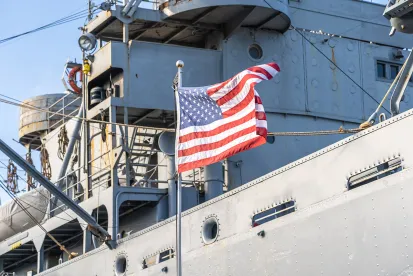About a year ago, we wrote about a rise in enforcement of the U.S. Environmental Protection Agency’s (“EPA”) Vessel General Permit (“VGP”). In the words of one EPA attorney, that was “just the beginning” and we have continued to see more aggressive reviews of VGP compliance and penalty demands, particularly on the U.S. West Coast. Since then, EPA has continued demanding significant penalties for alleged violations, sometimes citing interpretations of the VGP that are not outlined in any guidance documents. Additionally, in January 2023, EPA published an Enforcement Alert, EPA Reminder About Clean Water Act Vessel General Permit Requirements, reminding the maritime industry of the VGP requirements and impacts of non-compliance, and citing recent enforcement examples.
The VGP and VIDA Implementation
The VGP was issued under the Clean Water Act’s (“CWA”) National Pollutant Discharge Elimination System (“NPDES”) program and provides permit coverage nationwide for discharges incidental to the normal operation of commercial vessels more than 79 feet in length. EPA issued the first version of the VGP in 2008 and then another, more stringent version in 2013. The VGP set effluent limits and mandated Best Management Practices to control certain types of incidental discharges. It also required vessels to conduct routine and annual inspections and imposed numerous recordkeeping obligations, as well as monitoring and reporting requirements.
The 2013 VGP was set to expire in December 2018 and a new VGP was to be issued. However, in December 2018, the Vessel Incidental Discharge Act (“VIDA”) was signed into law, with the intent of replacing the VGP and bringing uniformity, consistency, and certainty to the regulation of incidental discharges throughout the United States from U.S.-flag and foreign-flag vessels alike. VIDA amended the CWA and will substantially alter how EPA and the United States Coast Guard (“USCG”) regulate vessel discharges. VIDA required EPA to finalize uniform performance standards for each type of incidental discharge by December 2020, a deadline that the EPA has missed by more than two years already, and required the USCG to implement EPA’s final standards within two years.
Significantly, on January 19, 2023, EPA announced plans to issue a Supplemental Notice in Fall 2023 to its Vessel Incidental Discharge National Standards of Performance proposed rule, originally issued in October 2020 but never finalized. EPA indicated that the Supplemental Notice is intended to clarify its proposed rule, share ballast water data compiled by the USCG, and propose additional regulatory options that EPA is considering. EPA plans to request comments on the issues identified in the Supplemental Notice prior to finalizing its performance standards in Fall 2024—nearly four years after the deadline mandated by Congress. Once EPA finalizes its performance standards, VIDA requires the USCG to promulgate regulations implementing EPA’s standards, including equipment, compliance, monitoring, inspections, and enforcement, within two years. Until such time as VIDA is fully implemented, likely in late 2026, the VGP will remain in effect.
Litigation by Environmental Groups
EPA’s delay in finalizing its performance standards prompted the Center for Biological Diversity and Friends of the Earth to file a lawsuit in February 2023 to force EPA to finalize its standards. The plaintiffs seek a declaration by the court that EPA’s failure to finalize the incidental discharge standards violates the Clean Water Act and ask the court to order EPA to implement final standards within 60 days.
The premise of the environmental groups’ complaint is that EPA’s inaction harms aquatic ecosystems, with the principal allegations focused on ballast water discharges. The environmental groups allege that vessel pollution contributes to a range of environmental and public health problems, and that pollutants from vessels include aquatic invasive species, oil and grease, toxic chemicals, metals, plastics, and pathogens.
VGP Enforcement
Up until about two years ago, EPA had brought only a handful of enforcement actions for VGP violations. The penalties for these violations ranged from letters of warning and de minimis monetary penalties for minor violations, to fines between $20,000 and $40,000 for more serious discharge violations.
In recent years, however, EPA has begun a targeted VGP enforcement campaign, particularly in Regions 6, 9, and 10.[1] Although EPA has conducted vessel inspections for VGP compliance with the USCG during port state control inspections enforcement actions generally seem to begin with a close review of vessels’ Notices of Intent, Annual Reports, and National Ballast Information Clearinghouse (“NBIC”) reports. Findings of self-reported violations in Annual Reports or conflicting information in Annual Reports and NBIC reports inevitably trigger EPA to informally request additional information on VGP compliance issues, which in turn may lead to demands for significant penalties. EPA’s enforcement method has largely consisted of informal allegations followed by settlement negotiations regarding the alleged violations.
Some key areas where EPA has focused:
-
-
-
Annual Comprehensive and Routine Inspections—Failures to conduct annual comprehensive or routine inspections must be included in each vessel’s Annual Report so they are easy for EPA to identify and assess penalties. The fact that the violations were self-reported has not resulted in a significant mitigation of penalties.
-
Ballast Water Monitoring – This is of great interest to EPA. Failure to conduct the required monitoring for ballast water management systems is a common omission and must be reported. Key issues include annual calibration, functionality monitoring, and analytical sampling.
-
Ballast Water Exchange—EPA has begun focusing on vessels managing ballast water by exchange in accordance with a compliance date extension issued by the USCG, considering this to be a VGP violation if any other VGP violations are present, seemingly disregarding the intent and history behind USCG extensions and EPA’s Enforcement Response Policy.
-
-
EPA is applying its penalty calculation policies very aggressively, resulting in high penalty demands for every violation type, substantially higher than in the first 10+ years of VGP enforcement. Every violation, even paperwork violations, is considered to have presented a risk to the marine environment.
Conclusion
With EPA’s focus on VGP compliance and enforcement, as evidenced by its January Enforcement Alert, it is critical for companies to closely review VGP compliance for the vessels in their fleet and implement strict oversight and quality control, including audits, to ensure VGP requirements are complied with, crew are trained, and any deficiencies are promptly corrected. It is also important to ensure that all filings are accurate, including the Annual Reports filed in February for calendar year 2022.
FOOTNOTES
[1] Region 6 serves Arkansas, Louisiana, New Mexico, Oklahoma, and Texas; Region 9 serves Arizona, California, Hawaii, Nevada, and the Pacific Islands; and Region 10 serves Alaska, Idaho, Oregon, Washington, and 271 Native Tribes.




 />i
/>i

